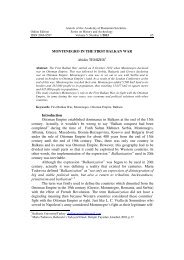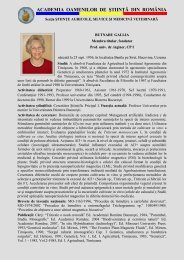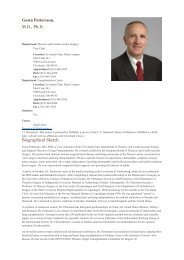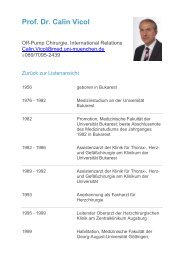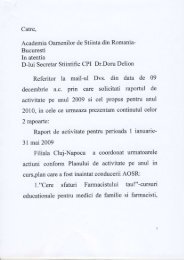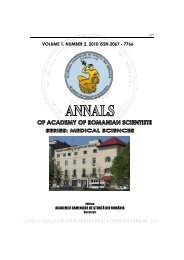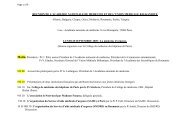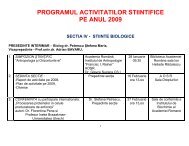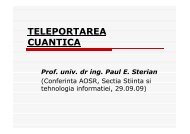Volume 3 nr 1 / 2011 - Academia Oamenilor de Stiinta din Romania
Volume 3 nr 1 / 2011 - Academia Oamenilor de Stiinta din Romania
Volume 3 nr 1 / 2011 - Academia Oamenilor de Stiinta din Romania
- No tags were found...
You also want an ePaper? Increase the reach of your titles
YUMPU automatically turns print PDFs into web optimized ePapers that Google loves.
112 Liviu Muresan, Septimiu Caceulately paying enhanced attention to organized cybernetic attacks, capable of<strong>de</strong>stabilizing the national infrastructure, the economy or even all components ofthe national security. The technical complexity required for such an attack israther high and partly explains why no such attacks have been recor<strong>de</strong>d so far.There were cases where attackers exploited some vulnerability and <strong>de</strong>monstratedthat they have even bigger <strong>de</strong>structive capabilities.In peace time, interested persons or organisations can initiate sabotage actions onthe state institutions, scientific research centres, private companies and otherstrategic objectives. In a scenario of confrontations, there is the possibility ofpreparing the ground for attacking within the cyber space, through mapping theinformation systems of the state, i<strong>de</strong>ntifying the main targets and placing hid<strong>de</strong>nentry points or other means of access within the national infrastructure.During times of crises or war, adversaries can try to intimidate or block nationalpolitical lea<strong>de</strong>rs’ freedom of action, by attacking the critical infrastructures andthe basic functions of the economy or by ero<strong>din</strong>g public trust in the governing orinformational systems. Cyber-attacks on the information networks of any countrycan have serious consequences, such as the interruption of the functioning of keycomponents, causing losses of material and intellectual property or even of humanlives.4. European Critical InfrastructuresThe actions mentioned earlier lead to the fact that a process was started atEuropean Commission level, for the <strong>de</strong>veloping of normative proposals in thefield of Critical Infrastructure Protection. These projects were finalised andpresented to the European Parliament, some of them started in 2005 and the restof the documents in December 2006.The documents are currently being <strong>de</strong>bated and the European Parliament willendorse the legislation, norms and recommendations, which shall <strong>de</strong>fine thecritical infrastructures of European interest and regulate the measures for theirprotection in the context in which each Member state will be required to <strong>de</strong>fineand <strong>de</strong>velop specific internal measures, taking especially into consi<strong>de</strong>ration thestructures <strong>de</strong>fined as vital at European level.Up to the present moment, several counties - Austria, France, Germany, GreatBritain, Italy, Norway, Swe<strong>de</strong>n, Switzerland, and Spain have created specificorganisms, have <strong>de</strong>veloped methodologies, and have allocated substantial fundsfor the protection of the infrastructures they <strong>de</strong>fined as critical.The European Council, at its June 2004 meeting, has required the EuropeanCommission and the High Representative to <strong>de</strong>velop a global strategy regar<strong>din</strong>gthe consolidation of critical infrastructures and their protection.Copyright © Editura Aca<strong>de</strong>miei <strong>Oamenilor</strong> <strong>de</strong> Știință <strong>din</strong> România, <strong>2011</strong>Watermark Protected



